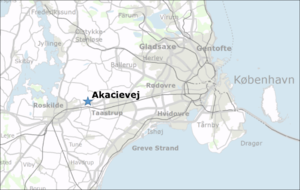Introduction and background
This Wiki is part of the Region H Limestone Project, a collaboration between DTU Environment at the Technical University of Denmark and Region H about the fate of contaminants in fractured limestone aquifers. The limestone project aims at improving our understanding of contaminant transport in fractured limestone aquifers and to identify and develop appropriate tools for the assessment and remedial planning of contaminated sites. The project involves a combination of field and lab work, and modeling of field data.
The project goals are to
- enhance the conceptual understanding of the behavior of contaminants in fractured limestone aquifers, which are one of the major drinking water resources in Denmark and other countries
- develop and test appropriate mathematical models for the quantitative description of processes, e.g. for risk assessment or the planning of a remediation strategy
- test and evaluate field methods for the determination of relevant hydraulic data and transport properties, which are a prerequisite for modeling
- test and compare sampling and analysis methods for the characterization of contaminants (distribution in the aquifer, localization of DNAPL)
- contribute to the development and evaluation of contaminant remediation methods
Background
The understanding of the fate and transport behavior of contaminant plumes from contaminated sites in limestone aquifers is important because these aquifers are often a major drinking water resource. This is challenging because limestone aquifers may be heavily fractured and contain chert layers and nodules, resulting in a complex flow and transport behavior. Standard field methods may give poor or misleading results and more advanced techniques, which can give information about processes and conditions in the fractures and in the limestone matrix are required. Different field methods have been developed in the past to better characterize the flow field and transport behavior in such aquifers. Moreover, specialized methods for determining aquifer parameters and estimating the contaminant distribution in fractured aquifers have been shown to be useful.
To enhance the conceptual understanding of the behavior of contaminants in fractured limestone aquifers and to test modeling tools and field methods, a pumping test combined with multiple tracer injections and contaminant sampling was conducted at a PCE contaminated field site close to Copenhagen. This gave some important insights and the impacts on the conceptual understanding of processes in fractured limestone will be discussed. This wiki gives an overview and evaluates some useful methods for the determination of relevant field data and for the assessment of contaminant plumes in fractured limestone aquifers. The focus is on dissolved chlorinated solvents (PCE, TCE etc.) as contaminants.
Modeling can help with the planning and interpretation of field work and is a viable tool for the prediction of the contaminant behavior in the aquifer. It is, however, important to select an appropriate model, which accounts for the fractured nature of the aquifer and does not oversimplify the studied system, leading to wrong predictions. Then, it can be used as a tool to advance the conceptual understanding and to guide with decision support for risk assessment and remedial site management.
Structure of the wiki
The Limestone wiki is composed of two major parts:
- Data acquisition and conceptual model development
- Modeling contaminant transport in limestone
The first part focuses on methods to obtain data about the geology and hydrogeology and the contaminant distribution. It will be shown, how data from field and lab measurements is used for the improvement of a conceptual model.
The second part of this wiki aims at giving an overview of modeling tools that can be used for the interpretation and prediction of flow and transport processes in fractured limestone aquifers (Chapter Model concepts). Fracture flow and transport models with different complexity are available for the modeling of contaminant transport, ranging from simple spreadsheet tools to advanced models that incorporate the fracture geometry. The models will be compared for their suitability to simulate field data and to represent typical features of fracture flow and transport based on a field example. Based on that, it will be exemplified how to establish a conceptual model for a contaminated site and how different field measurements contribute to the model development. The steps how to build up a numerical model will be described and recommendations for a good modeling practice will be made.
Return to Content
